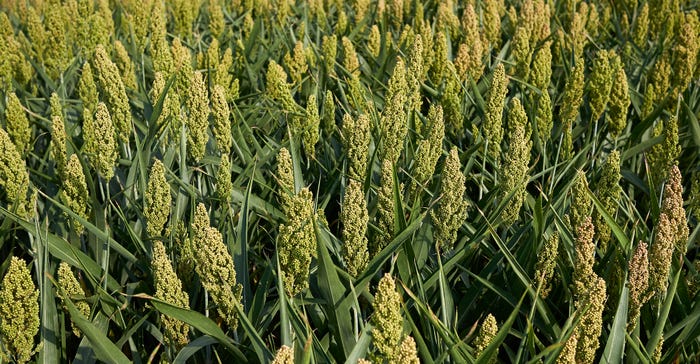
New aphids are showing up in grain sorghum across Kansas. J.P. Michaud, an entomologist at Kansas State University Research and Extension, says while they remain lower in numbers, growers should keep them on their radar when scouting fields.
“We now have at least six species of aphids active in the milo — actually seven — but I’m not going to include the mealy plum aphid because I’ve only found it once in the state,” Michaud says.
Here are the aphids to keep an eye on:
Greenbug. For Michaud this aphid is one of the “most notorious” aphids affecting sorghum but is no longer as bad it was in the 1970s and 1980s. “The only time now we see significant numbers of greenbug is usually when they piggyback on an outbreak of another aphid species,” he explains. “We saw that with sugarcane aphid.” He is concerned about the potential for greenbug to combine with corn leaf aphid and infest the flowers. “When they do that, they cause complete sterility, so you have completely empty heads.”
Corn leaf aphid. This aphid was considered “beneficial” during whorl stage. The corn leaf aphid arrives early, travels down and starts a colony deep in the whorl. Corn leaf aphid does no harm at that growth stage in the crop, Michaud explains. It will produce a lot of honeydew, which can drain the plant’s resources at later growth stages.
However, the corn leaf aphid is arriving much later in the crop cycle, especially over the last four years. Michaud says this aphid is colonizing the flag leaves at the boot stage. At that point, they’re able to move into the heads, and bring with them honeydew and mold. “And it also makes it easier for the damaging species to colonize the plant during reproductive stages, and this is precisely when the plants are more vulnerable,” he adds. “They're putting all their resources into seed, so they don’t have as much available to resist insect attack.”
He says corn leaf aphid, when it comes early, is a beneficial pest, and sorghum growers should not spray it at the whorl stage. However, when it comes late, it can be part of a larger aphid problem very easily, and farmers should consider control measures for mixed populations of aphids in the heads.
Sugarcane aphid. There is a high rate of reproduction with this aphid on susceptible varieties. Michaud says it is worth scouting in the fields as the grain sorghum heads start emerging. There has been better control of sugarcane aphid to the south in recent years, so that means growers should not see as many sugarcane aphids migrating to Kansas as five or six years ago.
Because the sugarcane aphid is a subtropical species, it’s one of the latest to arrive in sorghum fields. Michaud says later-planted fields will remain more at risk, and early planting will offer a good means of cultural control.
Sipha flava, or the yellow sugarcane aphid, and Sipha maydis are both in Kansas, but in low numbers. Sipha maydis is a brownish-black color and covered with bristle hairs, much like that of a tiny hedgehog. Both cause red lesions on the plant where they have been feeding similar to damage from greenbug feeding.
Rusty plum aphid. This is the aphid Michaud finds regularly in very small colonies across the state, and he does not think it will ever cause economic problems “However, if we get an outbreak of any one aphid species, whether region-wide or just in a particular field, all aphid species present can participate because they all share the same natural enemies. So, when the natural enemies are overwhelmed, they all escape control together.” This is what sorghum growers saw when the sugarcane aphid was abundant.
Bugs that eat aphids
While seed treatments are effective against aphids early in the crop cycle, Michaud points out that grain sorghum does not have pest problems in seedling or whorl stage, as growers sometimes do with the crop in the Southern states.
He says farmers should try and avoid insecticidal seed treatments on sorghum seed because they impact the aphid’s natural enemies, which include:
• lady beetles
• parasitoid wasps
• green lacewings
• syrphid flies
“It’s not a good thing to have no aphids in the crop,” Michaud says, “because then you leave the natural enemies with nothing to eat.” Sorghum growers need these beneficials to be around for protection later in the season, when the damaging aphids come in on winds from Texas.
He adds that most often, a baseline population of beneficial insects in a field is all farmers need to manage aphid infestations when they do arrive.
About the Author(s)
You May Also Like






